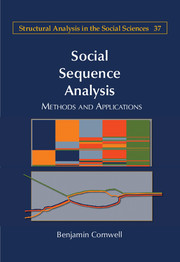Book contents
- Frontmatter
- Contents
- List of Figures
- List of Tables
- Preface
- Acknowledgments
- PART I INTRODUCTION
- 1 Sequence Analysis in the Social Sciences
- PART II THEORETICAL BACKGROUND
- PART III SOCIAL SEQUENCE ANALYSIS CONCEPTS AND TECHNIQUES
- PART IV NEW DIRECTIONS IN SOCIAL SEQUENCE ANALYSIS
- PART V CONCLUSIONS
- Appendix A Recent Whole-Sequence Pattern Analyses
- Appendix B Linkage Criteria for Agglomerative Hierarchical Clustering
- References
- Index
- Recent Books in the Series (continued from page iii)
1 - Sequence Analysis in the Social Sciences
from PART I - INTRODUCTION
Published online by Cambridge University Press: 05 July 2015
- Frontmatter
- Contents
- List of Figures
- List of Tables
- Preface
- Acknowledgments
- PART I INTRODUCTION
- 1 Sequence Analysis in the Social Sciences
- PART II THEORETICAL BACKGROUND
- PART III SOCIAL SEQUENCE ANALYSIS CONCEPTS AND TECHNIQUES
- PART IV NEW DIRECTIONS IN SOCIAL SEQUENCE ANALYSIS
- PART V CONCLUSIONS
- Appendix A Recent Whole-Sequence Pattern Analyses
- Appendix B Linkage Criteria for Agglomerative Hierarchical Clustering
- References
- Index
- Recent Books in the Series (continued from page iii)
Summary
Social actors of all kinds – individuals, families, organizations – are connected to each other and to larger society through ordered elements, states, and events. To be socially connected is to experience fluctuating environments, evolving relationships, shifting preferences and strategies, changing statuses, and constant flows of information and resources. As several important social science theories suggest, examining the timing and order of these elements of social life is the only way to understand social structure (e.g., Bales 1951; Blumer 1969; Bourdieu 1984; Gershuny 2000; Giddens 1984; Parsons 1951; Sacks 1995; Schutz [1932] 1967; Strauss 1993; White 2008; Zerubavel 1981).
And yet, in contemporary social science, the effort to describe and analyze the sequential nature of social reality is often regarded as somewhat of an “offshore operation” (Abbott 2000:66) – something that is done by a few enthusiasts who are engaged in peripheral or exotic research. The overarching goal of this book is to change that perception. It does this both by pointing out that many scholars are already engaged in sequence analysis (often without realizing it) and by promulgating conventional and new sequence approaches.
Researchers are becoming both increasingly interested in and capable of analyzing sequential social phenomena. This book describes some of the most widely used methods that have been developed to study these dynamics and introduces some new techniques and applications as well. Sequence analysis takes a variety of forms in the social sciences, ranging from statistical Markovian and survival analysis approaches to conversation analysis techniques. These are all extraordinarily valuable approaches. This book will focus primarily on another class of sequence methods, which treat whole sequences, as well as larger networks of sequences, as units of study. These approaches allow researchers to study, measure, classify, and visualize sequences of social phenomena. I view these methods – which include sequence description techniques, optimal matching analysis, cluster analysis, sequence-network analysis, event structure analysis, and social microsequence analyses – as one part of the larger body of social sequence analysis methods.
- Type
- Chapter
- Information
- Social Sequence AnalysisMethods and Applications, pp. 3 - 18Publisher: Cambridge University PressPrint publication year: 2015

